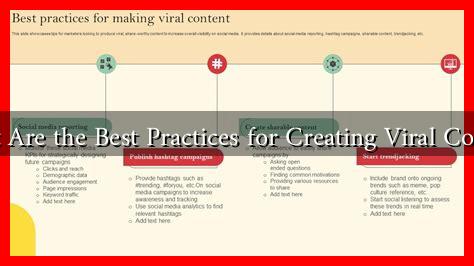-
Table of Contents
- What Are the Best Practices for Creating Viral Content?
- Understanding the Psychology of Sharing
- Best Practices for Creating Viral Content
- 1. Know Your Audience
- 2. Create High-Quality, Engaging Content
- 3. Leverage Current Trends and Events
- 4. Optimize for Social Media
- 5. Encourage Engagement and Interaction
- 6. Utilize Influencer Marketing
- Case Studies of Viral Content
- Conclusion
What Are the Best Practices for Creating Viral Content?
In the digital age, creating viral content is the Holy Grail for marketers, content creators, and brands alike. Viral content can significantly boost visibility, engagement, and ultimately, conversions. However, crafting content that resonates with audiences and compels them to share is no easy feat. This article explores the best practices for creating viral content, backed by research, examples, and actionable insights.
Understanding the Psychology of Sharing
Before diving into the best practices, it’s essential to understand why people share content. According to a study by the New York Times, the primary motivations for sharing include:
- To bring valuable and entertaining content to others.
- To define themselves to others.
- To grow and nourish their relationships.
- To get the word out about causes they care about.
By tapping into these motivations, content creators can craft messages that resonate deeply with their audience.
Best Practices for Creating Viral Content
1. Know Your Audience
Understanding your target audience is crucial. Conduct surveys, analyze social media interactions, and utilize tools like Google Analytics to gather insights about your audience’s preferences, interests, and behaviors. Tailoring your content to meet their needs increases the likelihood of shares.
2. Create High-Quality, Engaging Content
Quality is non-negotiable. Viral content often features:
- Strong visuals: Use high-resolution images, infographics, or videos to capture attention.
- Compelling storytelling: Narratives that evoke emotions tend to resonate more.
- Clear and concise messaging: Avoid jargon and keep your content easy to digest.
For example, BuzzFeed’s listicles often combine humor, relatable content, and eye-catching visuals, making them highly shareable.
3. Leverage Current Trends and Events
Timeliness can significantly enhance the shareability of your content. By aligning your content with current events or trending topics, you can tap into existing conversations. For instance, during the 2020 pandemic, many brands created content that addressed remote work challenges, which resonated with a broad audience.
4. Optimize for Social Media
Different social media platforms have unique characteristics. Tailor your content for each platform:
- Facebook: Use engaging headlines and visuals; consider using Facebook Live for real-time engagement.
- Twitter: Craft concise, witty tweets with relevant hashtags to increase visibility.
- Instagram: Focus on high-quality images and stories; use Instagram Reels for short, engaging videos.
According to a study by Buffer, posts with images receive 94% more views than those without.
5. Encourage Engagement and Interaction
Encouraging your audience to engage with your content can significantly increase its viral potential. Consider:
- Asking questions to prompt comments.
- Creating polls or quizzes that invite participation.
- Incorporating user-generated content to foster community.
For example, the Ice Bucket Challenge went viral not just because of its cause but also due to its interactive nature, encouraging people to participate and share their experiences.
6. Utilize Influencer Marketing
Partnering with influencers can amplify your reach. Influencers have established trust with their followers, making their endorsements powerful. A study by Nielsen found that 92% of consumers trust recommendations from individuals over brands. Collaborating with influencers can help your content reach a broader audience and increase its chances of going viral.
Case Studies of Viral Content
Several brands have successfully created viral content by implementing these best practices:
- Dollar Shave Club: Their launch video went viral due to its humor and relatability, leading to a massive increase in subscriptions.
- Old Spice: The “The Man Your Man Could Smell Like” campaign utilized humor and a strong narrative, resulting in a significant boost in sales.
Conclusion
Creating viral content is both an art and a science. By understanding your audience, producing high-quality content, leveraging trends, optimizing for social media, encouraging engagement, and utilizing influencer marketing, you can significantly increase your chances of creating content that resonates and spreads. Remember, while there is no guaranteed formula for virality, these best practices can guide you in the right direction. As you embark on your content creation journey, keep experimenting and analyzing what works best for your audience.
For more insights on content marketing strategies, check out HubSpot’s Marketing Statistics.

